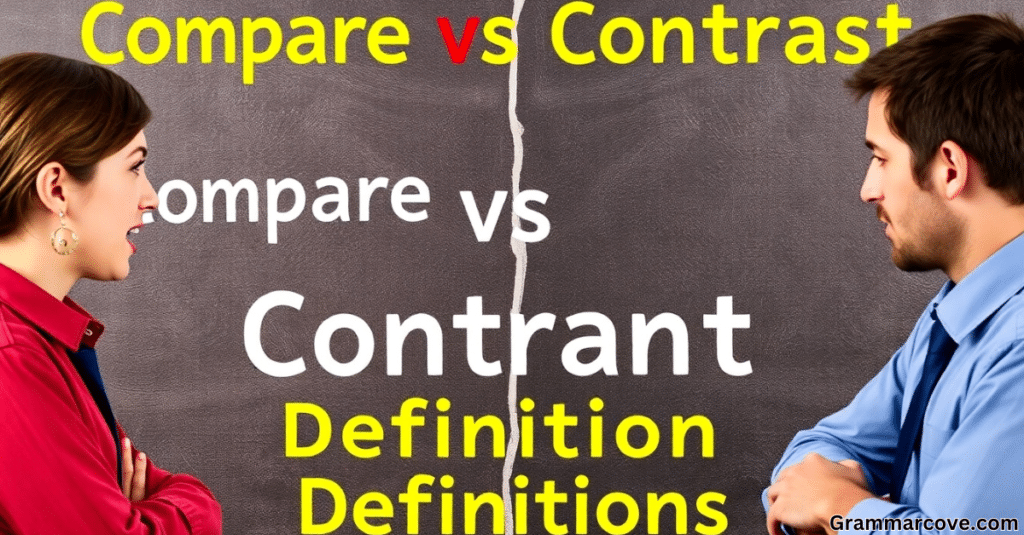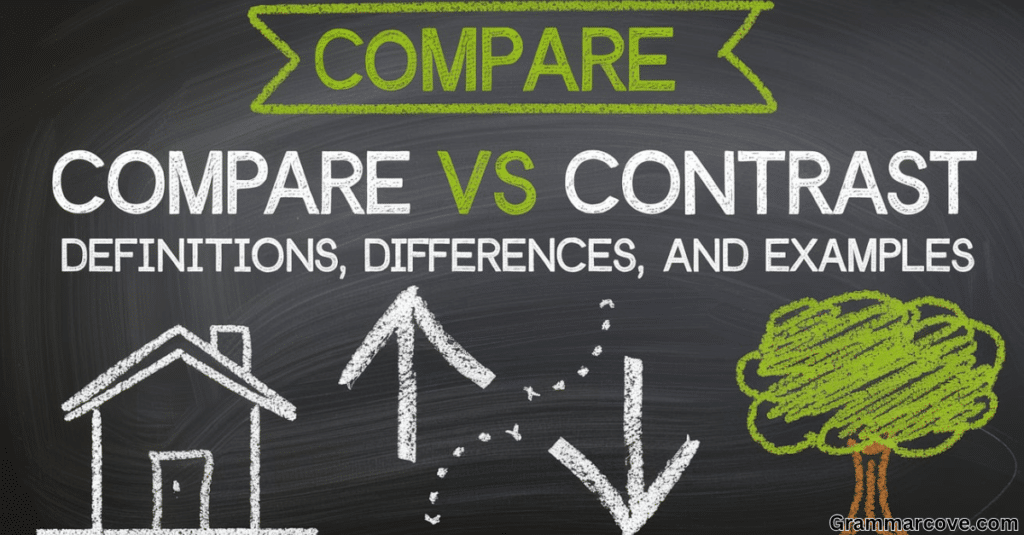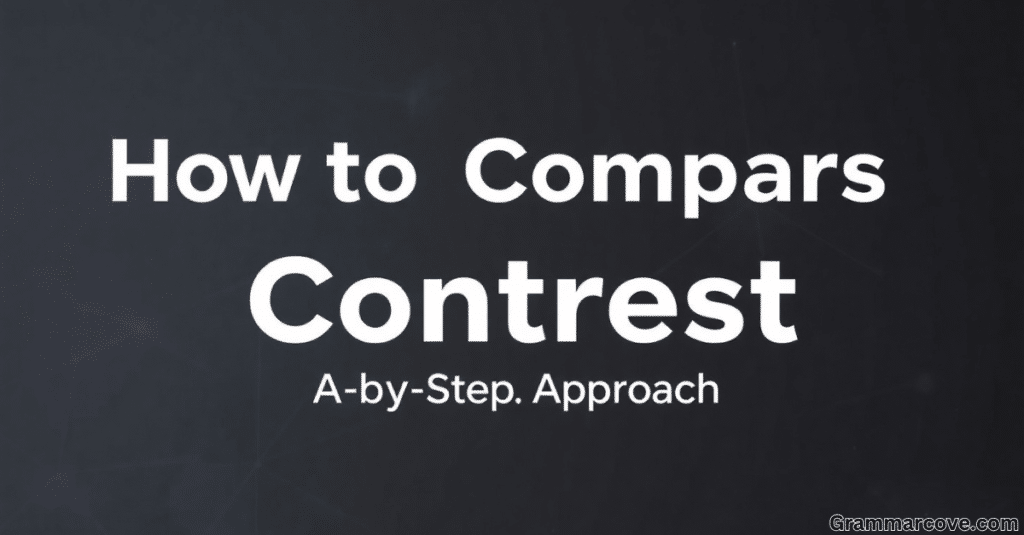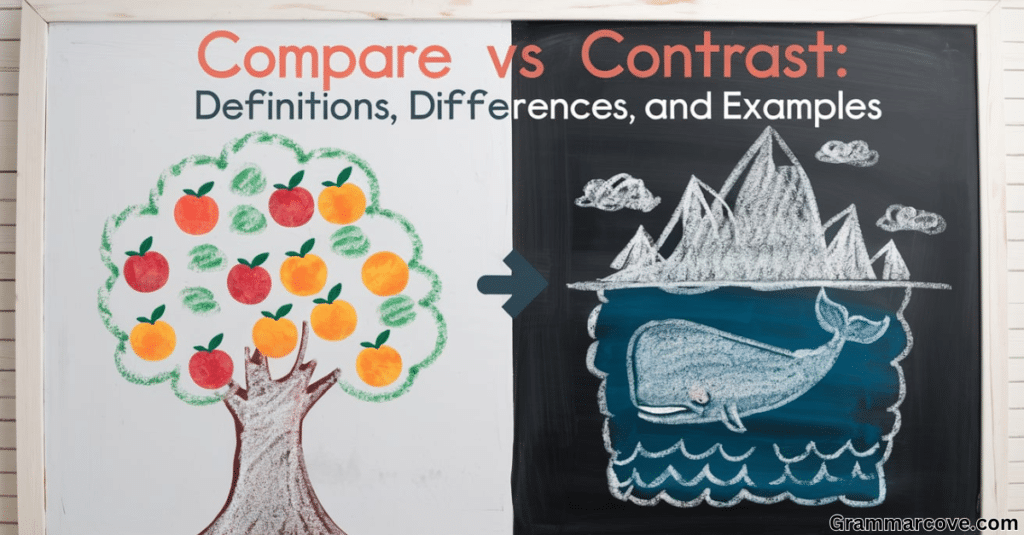The words “compare” and “contrast” are commonly used when discussing how two or more things are either similar or different. While these terms may seem similar, they carry distinct meanings that are crucial in various contexts, such as writing, analysis, or everyday conversations. Understanding the difference between compare and contrast can improve your ability to analyze, explain, and discuss different subjects clearly. This article will explore the definitions, differences, and examples of comparison and contrast, and provide a comprehensive understanding of their purposes and applications in writing, literature, and analysis.
Compare vs Contrast: Definitions

Before diving into the differences between these two concepts, let’s first define them clearly:
Compare Definition
To compare means to examine two or more items to identify similarities between them. The goal is to highlight what is common or alike between the subjects in question. When you compare, you’re essentially looking for connections, resemblances, or shared characteristics.
Example Scenario: Comparing Two Emails
Imagine you receive two emails from your colleagues, Sarah and John, regarding a new project. Both emails discuss the same task, but you want to identify their similarities:
- Sarah’s Email: “Hi team, I’ve just finished reviewing the project details. Everything seems to be on track, and I believe we can move forward as planned.”
- John’s Email: “Hello, team. I’ve gone through the project details. Everything looks good, and we’re ready to proceed with the next steps.”
You might compare these emails by noting that both Sarah and John convey the same message and tone, focusing on the project’s progress and readiness to move forward.
Contrast Definition
On the other hand, contrast refers to identifying differences between two or more things. When contrasting, you highlight the distinctive aspects, qualities, or features that set the subjects apart. Contrasting often emphasizes how two things are not alike.
Example Scenario: Contrasting Two Emails
Now, let’s take a look at the same two emails from Sarah and John but focus on their differences:
- Sarah’s Email: “Hi team, I’ve just finished reviewing the project details. Everything seems to be on track, and I believe we can move forward as planned.”
- John’s Email: “Hello, team. I’ve gone through the project details. Everything looks good, and we’re ready to proceed with the next steps.”
In this case, you might contrast these emails by pointing out that Sarah uses a slightly more cautious phrase like “seems to be on track”, whereas John is more confident, saying the project “looks good”. This reflects a difference in tone and certainty between the two.
Compare and Contrast Meaning

The phrase “compare and contrast” is often used when someone asks you to analyze both the similarities and differences between two or more items. In writing and analysis, you usually need to compare first, to establish what’s alike, then contrast, to outline the differences.
Purpose of Comparison
The purpose of comparison is to help you identify resemblances between items or ideas. It allows you to show how things share a common feature, attribute, or characteristic. This is useful when you want to explain how two subjects are related or when you’re highlighting common ground between different perspectives.
Purpose of Contrast
Conversely, the purpose of contrast is to clarify distinctions between two things. It helps to shed light on how one thing differs from another, often to emphasize a particular aspect or highlight an important difference. Contrast is essential when you’re analyzing the unique features of each item or discussing conflicting perspectives.
Compare vs Contrast: Key Differences
Understanding the compare and contrast difference is key to using both words correctly. Here’s a quick breakdown:
| Aspect | Compare | Contrast |
|---|---|---|
| Definition | To identify similarities between two or more things. | To identify differences between two or more things. |
| Purpose | To highlight common features or connections. | To emphasize differences or distinctions. |
| Focus | Focuses on what is alike. | Focuses on what is different. |
| Examples | Both items have similar qualities. | The items have distinct, contrasting features. |
| Use in writing | Used to create connections, establish relationships. | Used to showcase opposites or conflicting ideas. |
Comparing and Contrasting: A Case Study
Imagine you’re writing an essay comparing two novels, “Pride and Prejudice” by Jane Austen and “Moby-Dick” by Herman Melville. The comparison would focus on similarities, such as both novels being classics or exploring themes of human nature. In contrast, the contrast would point out how the novels differ in terms of genre, with “Pride and Prejudice” being a romance and “Moby-Dick” being an adventure novel, or the difference in setting (19th-century England vs. the open sea).
Examples of Comparison and Contrast in Context
In different writing styles, comparing and contrasting serve distinct purposes. Here are some examples of comparison and examples of contrast in real-world contexts.
Comparison in Analysis
When analyzing a topic, you often need to compare various aspects of it. For example, when discussing social media platforms, you might compare Facebook and Instagram:
- Both platforms are owned by the same company.
- Both allow users to post pictures and text.
- Both enable users to interact through likes, comments, and shares.
This comparison helps the reader understand that while the two platforms are similar in many ways, they are used for somewhat different purposes, with Facebook being more text-based and Instagram focused on images.
Contrast in Analysis
On the other hand, you might contrast the two platforms by focusing on their differences:
- Facebook allows longer posts and more diverse content (articles, events, etc.), whereas Instagram is more image-based and has a more visual orientation.
- The audience on Facebook tends to be older, while Instagram is more popular among younger users.
Examples of Comparison in Literature
In literature, comparing and contrasting is a valuable method of analysis. For example, comparing the works of two authors, William Shakespeare and Charles Dickens:
- Both authors have a profound influence on English literature.
- Both wrote about social issues of their time.
However, when contrasting their works:
- Shakespeare is known for his plays and sonnets, while Dickens is known for his novels.
- Shakespeare’s plays often revolve around universal human themes, while Dickens focuses more on Victorian society and the lives of the poor.
How to Compare vs Contrast: A Step-by-Step Approach

When tasked with comparing and contrasting, it helps to follow a systematic approach to ensure clarity. Here’s how you can effectively compare and contrast ideas:
- Identify the subjects: What two things are you comparing or contrasting? Are they people, objects, themes, or ideas?
- Determine the similarities (Comparison): List the common features that link these subjects together.
- Identify the differences (Contrast): Point out the distinctive features that make the subjects unique.
- Organize your findings: Present your comparison and contrast in a logical structure, such as in paragraphs or a table.
- Draw conclusions: Conclude by analyzing what the similarities and differences reveal about the subjects.
Comparative Phrases vs Contrasting Phrases
When writing, it’s important to use the correct comparative and contrasting phrases. Here are some examples:
Comparative Phrases
- Similarly
- In the same way
- Just as
- Like
- Both
Example:
“Just as Sarah’s email emphasizes the project’s progress, John’s email highlights the same point with equal clarity.”
Contrasting Phrases
- However
- On the other hand
- In contrast
- Unlike
- While
Example:
“Sarah is cautious about moving forward, while John is confident that the project is ready to proceed.”
Common Mistakes in Comparing and Contrasting
When comparing and contrasting, people often make these mistakes:
- Confusing comparison with contrast: Don’t mix up the two. Comparison is about similarities, while contrast is about differences.
- Focusing too much on similarities: While comparing, ensure that you also look at differences when needed.
- Not using clear transition words: Use words like “however”, “similarly”, or “on the other hand” to guide the reader through your analysis.
Conclusion: The Importance of Comparing and Contrasting
The ability to compare and contrast is fundamental to effective analysis, writing, and even day-to-day decision-making. By identifying both the similarities and differences between items, you gain a deeper understanding of their significance and relationships. Whether you’re writing an academic paper, making a decision, or simply analyzing the world around you, comparing and contrasting is a valuable skill to develop.


